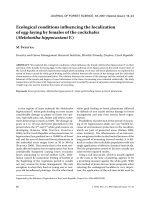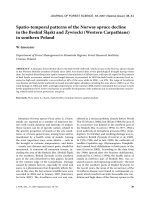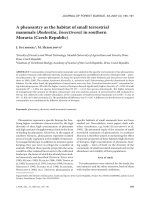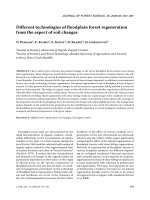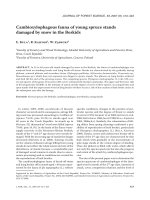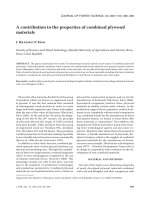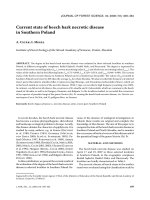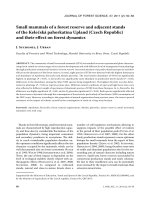Báo cáo lâm nghiệp: "Spatio-temporal patterns of the Norway spruce decline in the Beskid Śląski and Żywiecki (Western Carpathians) in southern Poland" pot
Bạn đang xem bản rút gọn của tài liệu. Xem và tải ngay bản đầy đủ của tài liệu tại đây (522.68 KB, 7 trang )
J. FOR. SCI., 53, 2007 (Special Issue): 38–44 38
JOURNAL OF FOREST SCIENCE, 53, 2007 (Special Issue): 38–44
Spatio-temporal patterns of the Norway spruce decline
in the Beskid Śląski and Żywiecki (Western Carpathians)
in southern Poland
W. G
Department of Forest Management in Mountain Regions, Forest Research Institute,
Cracow, Poland
ABSTRACT: A dramatic forest decline due to the bark beetle outbreak, which occurs in the Norway spruce stands
in the Western Beskidy (southern Poland) since 2003, was started after severe physiological drought during winter
time. An analysis describing some spatio-temporal characteristics of this process, with special regard to the patterns
of bark beetle occurrence related to root fungal diseases, is presented. In 2003 the bark beetle occurrence level as-
sessed as high and catastrophic was recorded on 40% of the area, while in 2006 – on 59%. e range of Armillaria
root disease and bark beetle outbreak increased towards higher altitudes, including the zone above 1,000 m a.s.l. e
wind damage in 2004 and 2007, and high temperatures in the summer 2006, further stimulated the increase in bark
beetle populations level. Some conclusions on possible development of the outbreak and recommendations concern-
ing related needs in forest protection, are given.
Keywords: Picea abies (L.) Karst.; bark beetles; mountain forests; spatial analysis
Mountain Norway spruce Picea abies (L.) Karst.
stands are exposed to a number of injurious fac-
tors with varied duration and intensity of impact.
ese factors can be of specific nature, related to
the specific properties of stands or the site condi-
tions, or of more general one, arising from and/or
manifested by a health crisis of stands. Among
the most important ones, some abiotic – such as
the drought or extreme temperatures, and biotic
– mainly tree diseases and insect pests, should be
mentioned. It concerns all mountain forests, in-
cluding the area of the Beskidy Mts. (Beskid Śląski
in the northern, Beskid Żywiecki in the southern
part of the area described in this paper), located
in the western edge of the Carpathians. Damage
caused by abiotic factors, especially by wind and
snow, is a phenomenon that frequently affects for-
ests in this area; the last serious windthrowns were
recorded in 2004 and in January 2007 (G,
J 2007). e Armillaria root rot was con-
sidered as a serious problem already before World
War II (M 2006), but till late 1980s the area of
its occurrence was limited to the northern part of
the Beskidy Mts. (C 1994). In 1977–1982 a
local outbreak of Zeiraphera griseana (Hb.) (Lepi-
doptera, Tortricidae) and resulting damage was re-
corded in Beskid Żywiecki (C et al. 1989).
In 1976–1986 and in late 1990s the outbreaks of
sawflies Cephalcia spp. (Hymenoptera, Pamphilii-
dae) caused local defoliations in both parts of the
area (J 2002). According to the data from
the 1980s (period after the heaviest defoliations),
analyzed by C (1994), the health status of
stands in northern part of Beskidy Mts. was as-
sessed as poor, and improving southward – the best
was in the southern parts of Beskid Żywiecki. In
the recent years, the areas of the occurrence of the
Armillaria disease were found to continuously ex-
pand, which results from both favourable site con-
ditions and high share of the Norway spruce in the
39 J. FOR. SCI., 53, 2007 (Special Issue): 38–44
stands (L, Ż 2006). Consequently, the
rapid build-up of the populations of bark beetles
feeding on Norway spruce, mainly Ips typographus
(L.), was observed. e resulting increase in the
tree mortality was recorded especially in the years
after 1996, with the first culmination about 1998
(G 2004). e process of the forest decline
in this region was continuously monitored in or-
der to define the patterns of tree mortality and the
spreading of bark beetle outbreak (G 2004,
2006). e repeated dramatic increase in the in-
tensity of the bark beetle attacks on standing trees
started in 2002–2003; in 2006 the situation turned
to catastrophic state, with a real risk of a total for-
est decline on large areas. is paper is aimed to
present the spatio-temporal characteristics of this
process during last 5 years in a mountain area cov-
ering Beskid Śląski and Beskid Żywiecki, in order
to better recognize the patterns of the bark beetle
occurrence in mountain conditions.
MATERIAL AND METHODS
e assessment of the intensity and dynamics of
the dying of stands was carried out on the basis of the
data collected in the SILP System (the Information
System of State Forests) concerning the harvesting
of dead, fallen and windthrown trees in 6 Forest
Districts in the Beskid Śląski and Beskid Żywiecki
(Bielsko, Jeleśnia, Ujsoły, Ustroń, Węgierska Górka
and Wisła), as a mountain area under the greatest
threat. e yearly data covering the period 2003 to
2006 were used. For this study a simple database
was built; it was arranged by forest compartments
as the basic area units. e assessment of the bark
beetle occurrence was based on the mean volume
of infested (standing and lying) trees removed an-
nually from 1 ha of stands. e classification of the
stands according to the particular degrees of tree
mortality and the occurrence of these insects was
based on the scale developed by C (1981)
in the version for the stands affected by Armillaria
spp. (Table 1). In order to visualize the data and to
describe the spatial distribution of the process, a
digital map covering most of the research area (ex-
cluding the northern parts of the Forest District
Bielsko and the eastern part of the Forest District
Jeleśnia), especially the layer encompassing the for-
est area units (from forest compartments to forest
districts) and major localities, was used.
As a case study for the altitudinal analysis the
Forest District Ujsoły was chosen. About 92% of its
total forest area is covered by Norway spruce stands
– it is the unit with the highest share of this species
among the forest districts in Beskid Żywiecki, and
almost the highest in the whole Western Beskidy
(C 1994). e stands older than 60 years con-
sist about 77% in terms of surface, but about 90% of
the wood volume is cumulated there (Strategia …
2007). Taking into account the species composition
and age, the susceptibility of these stands to bark
beetle attacks should be assessed as extremely high
(N, N-M 2005). For the analysis in
altitudinal aspect, the detailed digital map of the
Forest District Ujsoły was used.
All the thematic layers were generated and ana-
lyzed using the ESRI ArcView GIS 3.2 software.
RESULTS AND DISCUSSION
Dynamics of tree mortality
e last wave of the forest decline in the Beskidy
Mountains started after the winter 2002/2003, with
the weather conditions unfavourable for Norway
spruce (Strategia … 2007). e physiological stress
resulting from water shortage (drought) was the
direct factor affecting the decrease in tree vitality
and their higher susceptibility to the root diseases
and bark beetle attacks. A serious wind damage af-
fected the stands in the area of interest in late 2004
– the volume of broken and fallen trees processed
in 2005 was over 300 ths m
3
(Fig. 1). is resulted
in the size of sanitary cuttings in 2005 (higher than
in 2004, but including also lying, infested trees),
but also – in the volume of infested standing trees,
which was lower than in 2004. e real increase in
the tree mortality caused by bark beetle infestations
occurred in 2006. Extreme weather conditions dur-
ing the vegetation season stimulated the bark beetle
populations’ level build-up, and resulting tree mor-
tality. In conditions of extremely long vegetation
period (long and warm autumn), the development
of the pre-imaginal stages of bark beetles under the
Table 1. e classification of the stands according to the
particular degrees of occurrence of bark beetles and related
tree mortality
Volume of infested trees
(m
3
/ha/year)
Bark beetle occurrence level
0–0.4 normal
0.41–1.2 premonitory
1.21–2.4 abundant
2.41–10 high
10.01–20 and more catastrophic
J. FOR. SCI., 53, 2007 (Special Issue): 38–44 40
bark was very advanced; mostly adults entered in
winter diapause. In consequence, the attack poten-
tial of swarming adults in the spring of 2007 was
very high.
Spatial aspect
e bark beetle outbreak affected the Norway
spruce stands in almost the whole area of the West-
ern Beskidy region. Along with the increase of the
size of salvage cuttings (including the removal of in-
fested trees) the area of stands affected by the forest
decline increased too (Fig. 2). In 2003 (the first year
of the last “wave” of the outbreak) the tree mortal-
ity assessed as “normal” (up to 0.4 m
3
/ha) occurred
on more than 30% of the total area of stands, while
the serious mortality (over 2.41 m
3
/ha – “high” and
“catastrophic” level) – on about 40% of the area. In
2006 the percentage of the area of stands in these
classes were 22 and 59%, respectively. e strongly
attacked stands occurred on the whole area, re-
gardless the results of previous assessment of their
vitality, health status and resistance to injurious
factors (Fig. 3).
Altitudinal aspect
e situation regarding sanitary cuttings and the
dynamics of bark beetle populations in the Forest
District Ujsoły was the same as in the whole region
(Fig. 4, cf. Fig. 1), including the serious wind dam-
age in 2004 and 2007.
Fig. 1. e size of sanitary cuttings and
the volume of processed trees infested
by bark beetles in 6 forest districts in
the Western Beskidy in 2002–2006
Fig. 2. e distribution of stands in
individual classes of the bark beetle
caused tree mortality regarding their
area in 2003–2006
sanitary cutting
trend line sanitary cutting
infested trees
trend line infested trees
(ths/m
3
)
Years
Infested
trees (m
3
/ha)
> 50
20.01–50
2.41–20
1.21–2.40
0.41–1.20
0.01–0.40
0
(%)
Years
R
2
= 1
R
2
= 0.97
41 J. FOR. SCI., 53, 2007 (Special Issue): 38–44
In 2003 most (60%) of the sanitary cuttings was
done in the lower mountain zone – up to 800 m
a.s.l., in the stands more attacked by Armillaria root
disease (Fig. 5). In the next years the tree mortality
in the upper zone (over 800 m a.s.l.) increased, up
to 50% in 2006; the mortality was relatively stable
only in the highest zone – over 1,000 m a.s.l. e
same altitudinal pattern occur in the other for-
est districts of the region, which can be supposed
based on the spatial distribution of attacked stands
in the whole vertical profile in 2006 (Fig. 3).
In the years of 1980 the occurrence of the root rot
caused by Armillaria spp. was recorded mainly in
the stands of the lower mountain zone; the stands in
Fig. 4. e size of sanitary cuttings and
the volume of processed trees infested
by bark beetles in the Forest District
Ujsoły in 2001–2006
sanitary cutting infested trees
trend lines
Years
160,000
140,000
120,000
100,000
80,000
60,000
40,000
20,000
0
(m
3
)
Wind damage
Fig. 3. Spatial distribution of
stands in individual classes of
the bark beetle caused tree mor-
tality in 6 forest districts of the
Western Beskidy in 2006
2006
R
2
= 1
R
2
= 0.95
J. FOR. SCI., 53, 2007 (Special Issue): 38–44 42
the southern (higher located) part of Beskid Śląski
and Żywiecki were considered as relatively free
from the disease (C 1994). In consequence
of the changes in the vitality of stands caused main-
ly by abiotic factors, the present occurrence of this
pathogen reached the altitude of about 1,100 m
a.s.l. (L, Ż 2006). e enlargement of
the zone affected by this disease (in both spatial and
altitudinal aspects) can be understood as the main
cause of bark beetle related spruce decline, but also
as an indicator of dramatic collapse in tree health
and vitality. e fast increase in the bark beetle pop-
ulation level, started and supported by favourable
breeding and weather conditions (warm summers,
wind damage, stressed trees), fits perfectly in the
patterns of their population dynamics as described
by theoretical model (C et al. 1987).
According to this model, the close relation exists
between the bark beetle population density and
the stand resistance: the higher is the number of
beetles attacking the trees, the stronger (more re-
sistant) trees are successfully colonized and killed.
In the present state we are facing the most acute
phase of the bark beetle outbreak, which is demon-
strated by very high potential of bark beetle attack,
resulting in very high tree mortality, even between
relatively “healthy” (= resistant) trees.
e rapid increase in the bark beetle caused
tree mortality in 2006 was stimulated by the ex-
treme weather conditions, supported by the effects
of large wind damage from late 2004. According
to the rules found in several areas, the impact of
Fig. 5. e distribution of the volume of
processed trees infested by bark beetles
in 4 zones of altitude (m a.s.l.) in the For-
est District Ujsoły in 2003–2006
windthrowns on the bark beetle populations usu-
ally occurs in the second vegetation season after
the damage (G et al. 2000; G et al.
2006a,b). As the repeated wind damage occurred
on large areas in early 2007, a further increase in
the risk, resulting from already high level of bark
beetle populations, can be expected also in 2008.
e I. typographus outbreaks usually develop in
very dramatic way, reflected by a rapid increase of
the insect populations and its spread (especially in
progradation phase) from already attacked parts
of stands to new tree spots. e outbreak is also
favoured by climatic conditions, such as high tem-
peratures, which is favourable for insect develop-
ment (S 2004). is increases the threat to
stands, resulting in a substantial tree mortality rate.
In these circumstances, the relevant control meas-
ures can be taken to reduce the damage (direct con-
trol) and to mitigate its possible further effects in
the form of stand weakening and their increased
vulnerability to bark beetle attacks. It concerns
mainly the timely removal of infested trees, as well
as the use of the trap logs and artificial pheromone
traps, according the rules adopted for the moun-
tain forests (G et al. 2003).
e effect of I. typographus outbreaks is a deep
change in the ecological conditions, caused by the
stand decline and also by the control measures
taken against this species. erefore, in the post-
outbreak stands, it is necessary to flexibly respond
to qualitatively new threats related to an increase in
the frequency of insects which, as they accompany
> 1,000
901–1,000
601–800
< 600
(%)
Years
43 J. FOR. SCI., 53, 2007 (Special Issue): 38–44
I. typographus, are usually considered species of
secondary significance (G 2003). is could
be a challenge for the forest protection services.
On the other hand, it is necessary to take pro-ac-
tive silvicultural measures, particularly in the scope
of spruce stand conversion, ensuring their greater
species diversification, according to the site condi-
tions.
Acknowledgements
e author thanks the State Forest Administra-
tion of the Forest Districts Bielsko, Jeleśnia, Ujsoły,
Ustroń, Węgierska Górka and Wisła for kindly pro-
viding the data and map used for the analyses pre-
sented in this paper, and Dr. M J for
the basic digital map used for data visualization.
Ref ere nces
CAPECKI Z., 1981. Zasady prognozowania zagrożenia oraz
ochrona górskich lasów świerkowych przed owadami na tle
szkód wyrządzanych przez huragany i okiść. Prace Instytutu
Badawczego Leśnictwa, 584: 3–44.
CAPECKI Z., 1994. Rejony zdrowotności lasów zachodniej
części Karpat. Prace Instytutu Badawczego Leśnictwa, Seria
A, 781: 61–125.
CAPECKI Z., GRODZKI W., ZWOLIŃSKI A., 1989. Gradacja
wskaźnicy modrzewianeczki Zeiraphera griseana Hb. (Le-
pidoptera, Tortricidae) w Polsce w latach 1977–1983. Prace
Instytutu Badawczego Leśnictwa, 689: 95–152.
CHRISTIANSEN E., WARING R.H., BERRYMAN A.A., 1987.
Resistance of conifers to bark beetle attack: searching for
general relationships. Forest Ecology and Management,
22: 89–106.
GÖTHLIN E., SCHROEDER L.M., LINDELÖW A., 2000.
Attacks by Ips typographus and Pityogenes chalcographus
on windthrown spruces (Picea abies) during the two years
following a storm felling. Scandinavian Journal of Forest
Research, 15: 542–549.
GRODZKI W., 2003. Wpływ syntetycznych feromonów na
zasiedlanie drzew pułapkowych przez rytownika pospo-
litego Pityogenes chalcographus (L.) (Col.: Scolytidae).
Sylwan, 11: 54–60.
GRODZKI W., 2004. Zagrożenie górskich drzewostanów
świerkowych w zachodniej części Beskidów ze strony szkod-
ników owadzich. Leśne Prace Badawcze, 2: 35–47.
GRODZKI W., 2006. reats to mountain Norway spruce
stands in the Carpathians from the insect pests. In:
GRODZKI W., OSZAKO T. (eds), Current Problems of
Forest Protection in Spruce Stands Under Conversion.
Warsaw, Forest Research Institute: 71–78.
GRODZKI W., JACHYM M., 2007. Aktualne problemy
ochrony lasów górskich w Polsce 2006/2007. In: KUNCA A.
(ed.), Aktuálne problémy v ochrane lesa. Zvolen, Národné
lesnícke centrum: 40–43.
GRODZKI W., LOCH J., ARMATYS P., 2006a. Występowanie
kornika drukarza Ips typographus (L.) w uszkodzonych
przez wiatr drzewostanach świerkowych masywu Kudłonia
w Gorczańskim Parku Narodowym. Ochrona Beskidów
Zachodnich, 1: 125–137.
GRODZKI W., STARZYK J.R., KOSIBOWICZ M., 2006b.
Wiatrołomy i owady kambiofagiczne, a problemy ochro-
ny drzewostanów świerkowych w Tatrzańskim Parku
Narodowym. In: MIREK Z., GODZIK B. (eds), Przyroda
Tatrzańskiego Parku Narodowego a Człowiek. Tom II
– Nauki biologiczne, Tatrzański Park Narodowy – Polskie
Towarzystwo Przyjaciół Nauk o Ziemi. Zakopane – Kra-
ków: 115–124.
GRODZKI W., STARZYK J.R., MICHALSKI J., 2003. Wybrane
problemy ochrony górskich drzewostanów świerkowych
przed szkodliwymi owadami. In: GRZYWACZ A. (ed.),
Drzewostany świerkowe. Stan, problemy, perspektywy roz-
wojowe. Sesja Naukowa Polskiego Towarzystwa Leśnego,
Ustroń-Jaszowiec: 77–91.
JACHYM M., 2002. Location, evolution and importance
of Cephalcia spp. (Hym.: Pamphiliidae) populations in
Carpathian Mountains. In: McMANUS M.L., LIEBHOLD
A.M. (eds), Proceedings Ecology, Survey and Management
of Forest Insects. USDA Forest Service, General Technical
Report NE-311: 145–146.
LECH P., ŻÓŁCIAK A., 2006. Uwarunkowania występowania
opieńkowej zgnilizny korzeni w lasach Beskidu Żywieckie-
go. Leśne Prace Badawcze, 2: 35–47.
MAŃKA M., 2006. Armillaria root rot in Beskidy Mountains
in research after World War II. In: GRODZKI W., OSZAKO
T. (eds), Current Problems of Forest Protection in Spruce
Stands Under Conversion. Warsaw, Forest Research Insti-
tute: 43–49.
NETHERER S., NOPP-MAYR U., 2005. Predisposition assess-
ment systems (PAS) as supportive tools in forest manage-
ment-rating of site and stand-related hazards of bark beetle
infestation in the High Tatra Mountains as an example for
system application and verification. Forest Ecology and
Management, 207: 99–107.
SAUVARD D., 2004. General biology of bark beetles. In:
LIEUTIER F., DAY K.R., BATTISTI A., GRÉGOIRE J.C.
(eds), Bark and Wood Boring Insects in Living Trees in
Europe, a Synthesis. Dordrecht, Boston, London, Kluwer
Academic Publishers: 63–89.
Strategia ograniczania liczebności szkodników wtórnych
świerka na obszarze Beskidu Śląskiego i Żywieckiego
w 2007 roku. Regionalna Dyrekcja Lasów Państwowych
w Katowicach, 2007.
J. FOR. SCI., 53, 2007 (Special Issue): 38–44 44
Časoprostorové zákonitosti rozpadu smrkových lesů v pohořích Beskid Śląski
a Żywiecki (západní Karpaty) v jižním Polsku
ABSTRAKT: Dramatický rozpad lesa způsobený gradací lýkožroutů, který nastal na smrkových stanovištích
v západních Beskydech (jižní Polsko) v roce 2003, byl nastartován silným fyziologickým suchem v průběhu zimní
-
ho období. Analýza popisuje časoprostorové charakteristiky tohoto procesu se zvláštním ohledem na zákonitosti
výskytu lýkožroutů v závislosti na kořenových hnilobách. V roce 2003 byla úroveň výskytu lýkožroutů hodnocena
jako vysoká a katastrofická a kůrovec byl zaznamenán na 40 % území, zatímco v roce 2006 již na 59 % území. Území
výskytu václavky a gradace kůrovce směřuje k vyšším nadmořským výškám (zahrnuje i zónu nad 1 000 m n. m.). Škody
větrem v letech 2004 a 2007 a vysoké teploty v létě 2006 dále napomáhají zvyšování početnosti populace lýkožroutů.
Jsou prezentovány závěry o možném rozvoji gradace a doporučení k potřebné ochraně lesa.
Klíčová slova: Picea abies (L.) Karst.; kůrovci; horské lesy; prostorová analýza
Corresponding author:
Dr. W G, Forest Research Institute, Department of Forest Management in Mountain Regions,
ul. Fredry 39, 30 605 Cracow, Poland
tel.: + 48 122 528 212, fax: + 48 122 528 202, e-mail:
